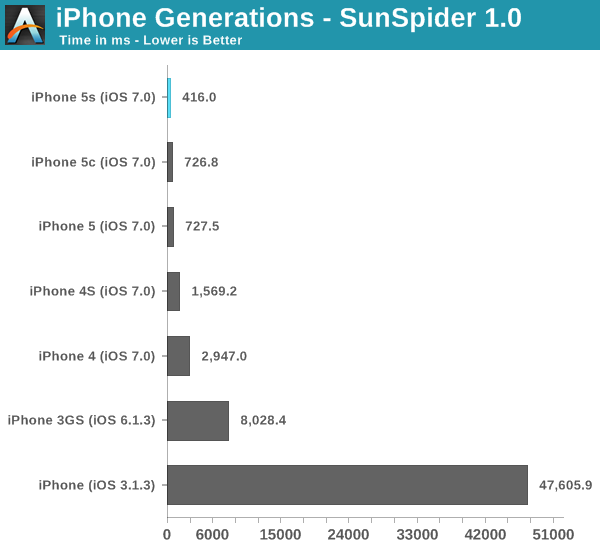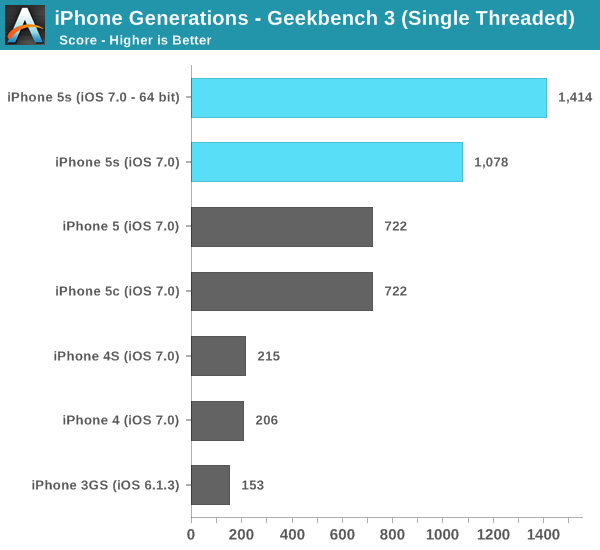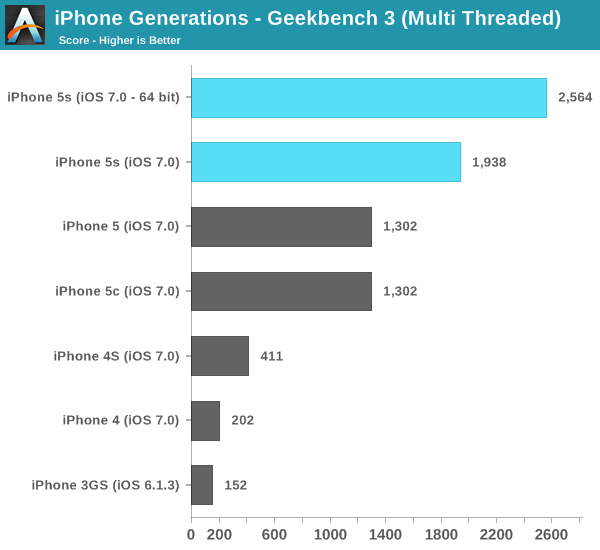The iPhone 5s Review
by Anand Lal Shimpi on September 17, 2013 9:01 PM EST- Posted in
- Smartphones
- Apple
- Mobile
- iPhone
- iPhone 5S
iPhone Performance Across Generations

Performance improved by a factor of 100x compared to the original iPhone. You can cut that in half if the iPhone could run iOS 4. Needless to say, Apple's CPU performance estimates aren't unreasonable. We've come a long way since the days when ARM11 cores were good enough.
Even compared to a relatively modern phone like the iPhone 4, the jump to a 5s is huge. The gap isn't quite at the level of an order of magnitude, but it's quickly approaching it. Using the single core iPhone 4 under iOS 7 just feels incredibly slow. Starting with the 4S things get a lot better, but I'd say the iPhone 4 is at the point now where it's starting to feel too slow even for normal consumers (at least with iOS 7 installed).

Browsermark 2.0 gives us a good indication of less CPU bound performance gains. Here we see over a 5x increase in performance compared to the original iPhone, and an 83% increase compared to the iPhone 4.
I wanted to have a closer look at raw CPU performance so I turned to Geekbench 3. Unfortunately Geekbench 3 won't run on anything older than iOS 6, so the original iPhone bows out of this test.

Single threaded performance scaled by roughly 9x from the 3GS to the iPhone 5s. The improvement since the iPhone 4/4S days is around 6.5x. Single threaded performance often influences snappiness and UI speed/feel, so it's definitely an important vector to scale across.

Take into account multithreaded performance and the increase over the 3GS is even bigger, almost 17x now.
The only 3D test I could get to reliably run across all of the platforms (outside the original iPhone) was Basemark X. Again I had issues getting Basemark X running in offscreen mode on iOS 7 so all of the tests here are run at each device's native resolution. In the case of the 3GS to 4 transition, that means a performance regression as the 3GS had a much lower display resolution to deal with.

Apple has scaled GPU performance pretty much in line with CPU performance over the years. The 5s scores 15x the frame rate of the iPhone 4, at a higher resolution too.
iPhone 5s vs. Bay Trail
I couldn't help but run Intel's current favorite mobile benchmark on the iPhone 5s. WebXPRT by Principled Technologies is a collection of browser based benchmarks that use HTML5 and js to simulate a number of workloads (photo editing, face detection, stocks dashboard and offline notes).

Granted we're comparing across platforms/browsers here, but the 5s as a platform does extremely well in Intel's favorite benchmark. The 5c by comparison performs a lot more like what we'd expect from a smartphone platform. The iPhone 5s is in a league of its own here. While I don't expect performance equalling the Atom Z3770 across the board, the fact that Apple is getting this close (with two fewer cores at that) is a testament to the work done in Cupertino.
At its launch event Apple claimed the A7 offered desktop class CPU performance. If it really is performance competitive with Bay Trail, I think that statement is a fair one to make. We're not talking about Haswell or even Ivy Bridge levels of desktop performance, but rather something close to mobile Core 2 Duo class. I've broken down the subtests in the table below:
| WebXPRT Performance (time in ms, lower is better) | ||||||
| Chrome/Mobile Safari | Photo Effects | Face Detection | Stocks | Offline Notes | ||
| Apple iPhone 5s (Apple A7 1.3GHz) | 878.9 ms | 1831.4 ms | 436.1 ms | 604.6 ms | ||
| Intel Bay Trail FFRD (Atom Z3770 1.46GHz) | 693.5 ms | 1557.0 ms | 542.9 ms | 737.3 ms | ||
| AMD A4-5000 (1.5GHz) | 411.2 ms | 2349.5 ms | 719.1 ms | 880.7 ms | ||
| Apple iPhone 5c (Apple A6 1.3GHz) | 1987.6 ms | 4119.6 ms | 763.6 ms | 1747.6 ms | ||
It's not a clean sweep for the iPhone 5s, but keep in mind that we are comparing to the best AMD and Intel have to offer in this space. I suspect part of why this is close is because both of those companies have been holding back a bit (there's no rush to build the fastest low margin parts), but it doesn't change reality.










464 Comments
View All Comments
ShAdOwXPR - Wednesday, September 18, 2013 - link
A7X win be a monster 130-150 GFLOPS that's Xbox 360 territory. Apple saying the A7 is a desktop class might be real with the benchmark numbers of the A7X...darkich - Thursday, September 19, 2013 - link
I expect the GPU on A7X to be even more impressive, approaching 200GFLOPS and easily beating the PS3/XBOX 360 in terms of graphical ability because of far more capable memory.It should be at least on par with the Intel HD 4000 at the fraction of TDP
AaronJ68 - Wednesday, September 18, 2013 - link
I only scanned the review, as I have a few things to do this afternoon. But tonight, during the baseball game, I plan on detailed read-through. Thank you.On the other side of the coin, iTunes Radio just played a Ke$ha song ... so ... :)
Onemanbucket - Wednesday, September 18, 2013 - link
Anand,I signed up here just to say that is the best, most educated review I have ever read. I was swaying between iPhone 5S and a Windows device (925) but your clear enthusiasm for the technology her has swung it.
Cheers.
Jumangi - Wednesday, September 18, 2013 - link
The advanced SoC is one part of making a quality day to day phone. Apple sticking to a tiny 4' screen in 2013 should be called out as unacceptable from any enthusiast site like Anandtech.beggerking@yahoo.com - Wednesday, September 18, 2013 - link
only 2 core...any multithreaded benchmark comparison vs typical Android quad cores?kinshadow - Wednesday, September 18, 2013 - link
What made you guess the 6430 over the 6400? I don't see anything in the article that really points either way.Gorgenapper - Wednesday, September 18, 2013 - link
Recently switched from an iPhone 4S to a Galaxy S4 Active. Two observations....with regards to what Anand said about iPhone users switching out of frustration:1) I would have been happy with a 4.5" ~ 4.7" screen on an iPhone. The IPS LCD panels on the iPhones are of the best quality and calibration in the industry, with the HTC One's screen coming a very close second place (not sure about the LG G2's, never seen one in person). But a 4" screen is too small, let alone the 3.5" screen on my iPhone 4S, and I just got sick of waiting for Apple to wake up.
2) iTunes
I can see #1 coming true when the iPhone 6 is up next, but #2 will never change.
darkcrayon - Wednesday, September 18, 2013 - link
And you need iTunes for what on a daily basis? That's a plus IMO, I like having an easy option for disk based backups and sync to multiple devices. I use it on Mac OS X though.Gorgenapper - Wednesday, September 18, 2013 - link
I'm on a pc.1) iTunes forces me to keep a separate folder structure for pictures, as I have many high res pics, zip files, rar files that would get synced regardless. I have to maintain the pics in this folder as well as those in my main picture folder(s).
2) Movies on the device are inextricably linked to those on the iTunes library, I can't manually get those movies off the device even if I accidentally wiped out the movies on my computer.
3) Kind of iTunes related (locked down filesystem), but the Camera Roll on my device stores the pictures in randomly-named folders, and they're all generically named IMG_****. It's a real pain to find and extract photos using Windows Explorer.
4) I can't use any free space on the phone to transport files like a USB drive (minor issue)
5) iTunes is slow to boot up, and the interface is not as intuitive (to me) as a simple Windows Explorer window.
6) I have often run into a problem where I manually delete a movie off my iPhone to make room for shooting video, then go to resync it and iTunes doesn't realize that the movie is missing - I have to unsync all the movies that are currently on the iPhone, then resync them all to get that movie back.